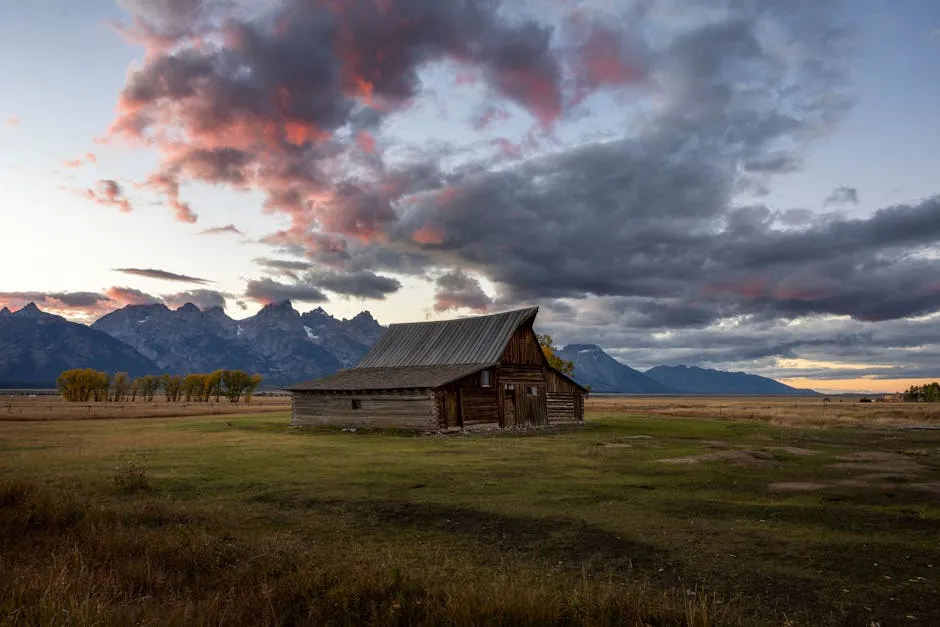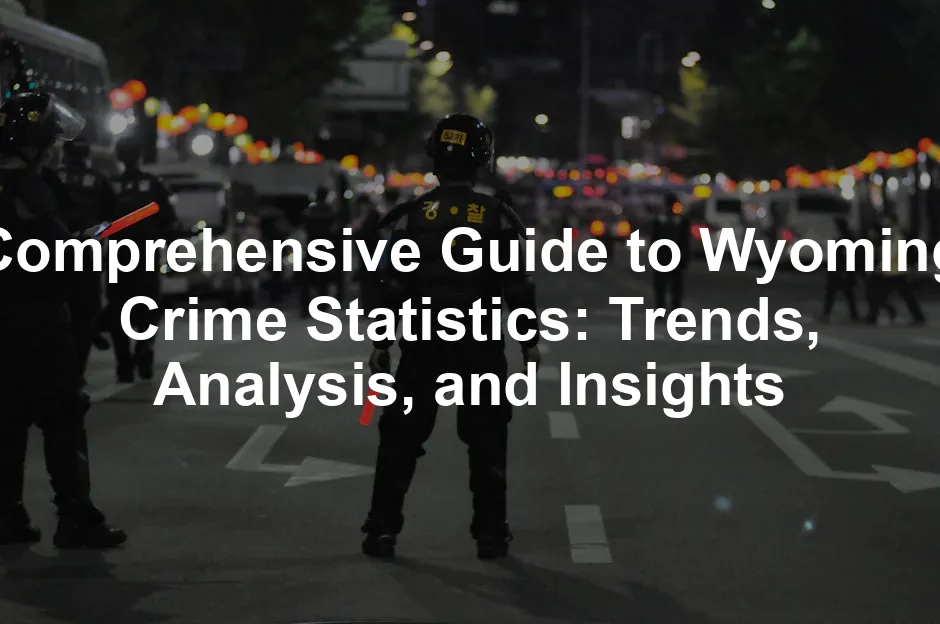Introduction
Understanding crime statistics in Wyoming is essential. They provide valuable insights for residents, policymakers, and law enforcement agencies. Why? Because crime trends can reveal patterns that are crucial in shaping community safety measures and resource allocation. This article aims to break down Wyoming’s crime statistics in detail. We’ll compare them with national averages, explore local trends, and offer insights into safety across various cities. With a low population density and vast natural landscapes, Wyoming presents a unique backdrop for crime analysis. While it’s known for its breathtaking beauty, this doesn’t mean it’s entirely free from crime. Picture this: as you enjoy a scenic drive through the Grand Teton National Park, the only crime you might think about is the one of forgetting your camera. Yet, in the cities, the reality may differ. Understanding these dynamics will empower you to navigate the state with enhanced awareness. By the end of this article, you’ll be equipped with a comprehensive understanding of Wyoming’s crime landscape, allowing you to make informed decisions about safety and community engagement. And speaking of community engagement, why not add a touch of Wyoming to your home with a Wyoming State Flag? It’s perfect for showcasing your pride while also serving as a reminder of the beauty of the Cowboy State!
Understanding Wyoming Crime Statistics
Overview of Crime Definitions
Before diving into the numbers, let’s clarify some key terms.- Violent Crime: This includes offenses such as murder, rape, robbery, and aggravated assault. These crimes involve force or the threat of force against individuals.
- Property Crime: This category encompasses burglary, larceny-theft, and motor vehicle theft. Essentially, these crimes involve the taking of someone else’s property without direct confrontation.

Historical Context of Crime in Wyoming
Wyoming’s crime history is as vast as its landscapes. Let’s rewind the clock to the 1960s. Back then, the state had a population of around 330,000. Crime rates were relatively low, with the violent crime index sitting around 109.7 per 100,000 people. Fast forward to today, and Wyoming’s population has increased, but crime trends have seen fluctuations influenced by various factors. In the 1970s and 1980s, crime rates began to creep up. The state’s economic changes, such as booms in mining and energy, sometimes brought along a rise in crime. In 1991, the violent crime rate hit a peak of 319.53. This was a significant jump, and it raised eyebrows across the state. However, the 1990s brought a shift. Crime rates started to decrease as law enforcement efforts ramped up and community programs were implemented. By the turn of the millennium, the violent crime rate had dipped to around 266.51, showcasing the positive impact of dedicated policing and community engagement. Legislation also played a role. The introduction of tougher sentencing laws and community policing initiatives helped curb crime. The early 2000s saw consistent efforts to tackle the rising drug problems, which were partly responsible for the violent crime spikes in the previous decades. Fast forward to the 2010s, and the trend continued. By 2019, the violent crime rate had dropped to 217.4 per 100,000, which was a positive sign for the state’s residents. Wyoming positioned itself as one of the safest states in the country concerning violent crime, with rates significantly below national averages. Today, understanding these historical trends is crucial. They help inform current policies, community initiatives, and law enforcement strategies aimed at maintaining safety in this beautiful state. As we move forward, we will analyze the latest crime statistics to see how these historical patterns have shaped the current landscape of crime in Wyoming. And while you’re digging into these stats, consider being prepared for any outdoor adventures with some quality Outdoor Survival Gear. You never know when you might need it!
Breakdown of Property Crimes
Property crimes in Wyoming paint a complex picture. In 2022, the state reported a total of 9,516 property crimes, resulting in a rate of 16.37 per 1,000 residents. This includes several categories:- Burglary: 1,218 incidents (2.10 per 1,000 residents)
- Larceny-theft: A staggering 7,354 incidents (12.65 per 1,000 residents)
- Motor Vehicle Theft: 944 cases (1.62 per 1,000 residents)
For more insights on crime trends in Wyoming, check out the Wyoming crime statistics.

Regional Crime Comparisons
Crime rates vary across Wyoming’s different regions. Notably, larger cities tend to report higher crime rates, while smaller towns often fare better. Here’s a snapshot of crime statistics for some of Wyoming’s key cities:| City | Population | Violent Crime Rate | Property Crime Rate |
|---|---|---|---|
| Cheyenne | 64,730 | 3.22 per 1,000 | 35.02 per 1,000 |
| Casper | 60,034 | 1.52 per 1,000 | 28.76 per 1,000 |
| Laramie | 32,632 | 0.92 per 1,000 | 13.76 per 1,000 |
| Riverton | 11,025 | 3.18 per 1,000 | 48.67 per 1,000 |
| Gillette | 32,826 | 1.25 per 1,000 | 17.30 per 1,000 |
| Thermopolis | 2,925 | 0.34 per 1,000 | 15.72 per 1,000 |

Demographic Insights
Wyoming’s demographics offer intriguing insights into its crime rates. The state’s population is primarily composed of white residents, with notable percentages of Hispanic and Native American communities. This demographic mix plays a role in shaping crime trends. Age is a key factor in understanding crime. Younger individuals, particularly those aged 18-24, often account for a higher percentage of both perpetrators and victims of crime. In Wyoming, this age group faces unique challenges, including limited job opportunities and a lack of social activities, which can contribute to higher crime rates. Gender also influences crime statistics. Males are statistically more likely to commit violent crimes than females. This trend is reflected in Wyoming, where the majority of violent crime offenders are male. However, female involvement in property crimes is increasing, suggesting changing social dynamics. Income levels matter too. Areas with lower socioeconomic status often see higher crime rates. In Wyoming, rural communities face economic challenges, leading to higher property crime rates as residents struggle to make ends meet. Research indicates a correlation between poverty and crime, emphasizing the need for targeted community support programs. If you’re looking to support local businesses, check out a Local Wyoming Craft Beer Sampler. Cheers to supporting your community!
Law Enforcement and Crime Prevention Strategies
Law enforcement plays a pivotal role in addressing crime in Wyoming. Community policing initiatives have gained traction, fostering partnerships between police and residents. This strategy emphasizes open communication and collaboration, making communities feel safer and more engaged. Successful programs have emerged in cities like Cheyenne. The Cheyenne Police Department has implemented numerous outreach initiatives, including neighborhood watch programs and youth engagement activities. These efforts have significantly decreased crime rates in targeted neighborhoods, demonstrating the power of collaboration. In Casper, the focus has been on property crime prevention. The city launched an awareness campaign about home security, encouraging residents to report suspicious activities. As a result, property crime rates have dropped, showcasing how proactive measures can yield positive outcomes. To equip yourself for safety, consider a First Aid Kit for emergencies. Moreover, statewide programs like the Wyoming Highway Patrol’s traffic safety initiatives have successfully reduced impaired driving incidents. By addressing specific crime categories, law enforcement in Wyoming is not just reacting to crime but actively preventing it.
Conclusion
Analyzing Wyoming’s crime statistics reveals several key takeaways. First, while Wyoming is often considered one of the safest states, it still faces challenges with property crimes. In 2022, the state reported a total of 9,516 property crimes, far outweighing the 1,174 violent crimes. This discrepancy is crucial for residents to understand, as it highlights the need for vigilance regarding personal belongings and community safety. Second, the historical context of crime trends in Wyoming shows a significant decline in violent crime rates over the past decades. This positive trend is largely attributed to proactive law enforcement strategies and community engagement programs. However, the fluctuating nature of property crime calls for ongoing efforts to ensure residents feel secure in their homes. If you’re planning a trip to Wyoming, don’t forget to bring along a Travel Guide to Wyoming to make the most of your adventure!
FAQs
What are the most common types of crime in Wyoming?
In Wyoming, the most common crimes include both violent and property offenses. – **Violent Crimes**: – **Murder**: In 2022, there were 15 reported cases. – **Rape**: The state saw 365 incidents, highlighting a significant concern. – **Robbery**: There were 46 reported robberies, a relatively low number. – **Assault**: With 748 cases, assault remains the most prevalent violent crime. – **Property Crimes**: – **Burglary**: Wyoming faced 1,218 burglary incidents. – **Larceny-theft**: This category dominated with 7,354 reported thefts. – **Motor Vehicle Theft**: There were 944 cases of this crime, underscoring the need for vehicle security.
How does Wyoming’s crime rate compare to other states?
Wyoming’s crime rate is notably lower than the national average. For violent crime, Wyoming ranks 46th in the U.S. with a rate of 2.02 per 1,000 residents, compared to the national median of about 4 per 1,000. In terms of property crime, Wyoming’s rate is also favorable, standing at 16.37 per 1,000 residents, which is lower than the national average of 20 per 1,000. When compared to neighboring states like Montana and Idaho, Wyoming generally maintains a safer profile.
What cities in Wyoming are considered the safest?
Several cities in Wyoming boast low crime rates, making them attractive for residents. – **Thermopolis**: Known for its peaceful environment, it has a low violent crime rate of 0.34 per 1,000. – **Worland**: This city has a violent crime rate of 62 per 100,000 residents. – **Newcastle**: With a crime rate of 63 per 100,000, it remains one of the safest cities in the state. These statistics illustrate that smaller towns and communities often offer a greater sense of security.
What resources are available for residents to report crime?
Residents can report crime through local law enforcement agencies. Each county typically has an office that handles crime reports. For immediate assistance, residents should contact the Wyoming Highway Patrol at 1-877-996-2724. Additionally, many police departments provide online reporting options for non-emergency incidents, making it easier for residents to communicate concerns.
How can I access more detailed crime statistics for Wyoming?
For comprehensive crime reports, residents can access the Wyoming Department of Criminal Investigation website. This site offers valuable information and statistics on crime trends. Additionally, the FBI’s Crime Data Explorer is an excellent resource for national and state crime statistics. Both platforms provide access to annual reports and detailed data for those interested in deeper insights into Wyoming’s crime landscape.
All images from Pexels




